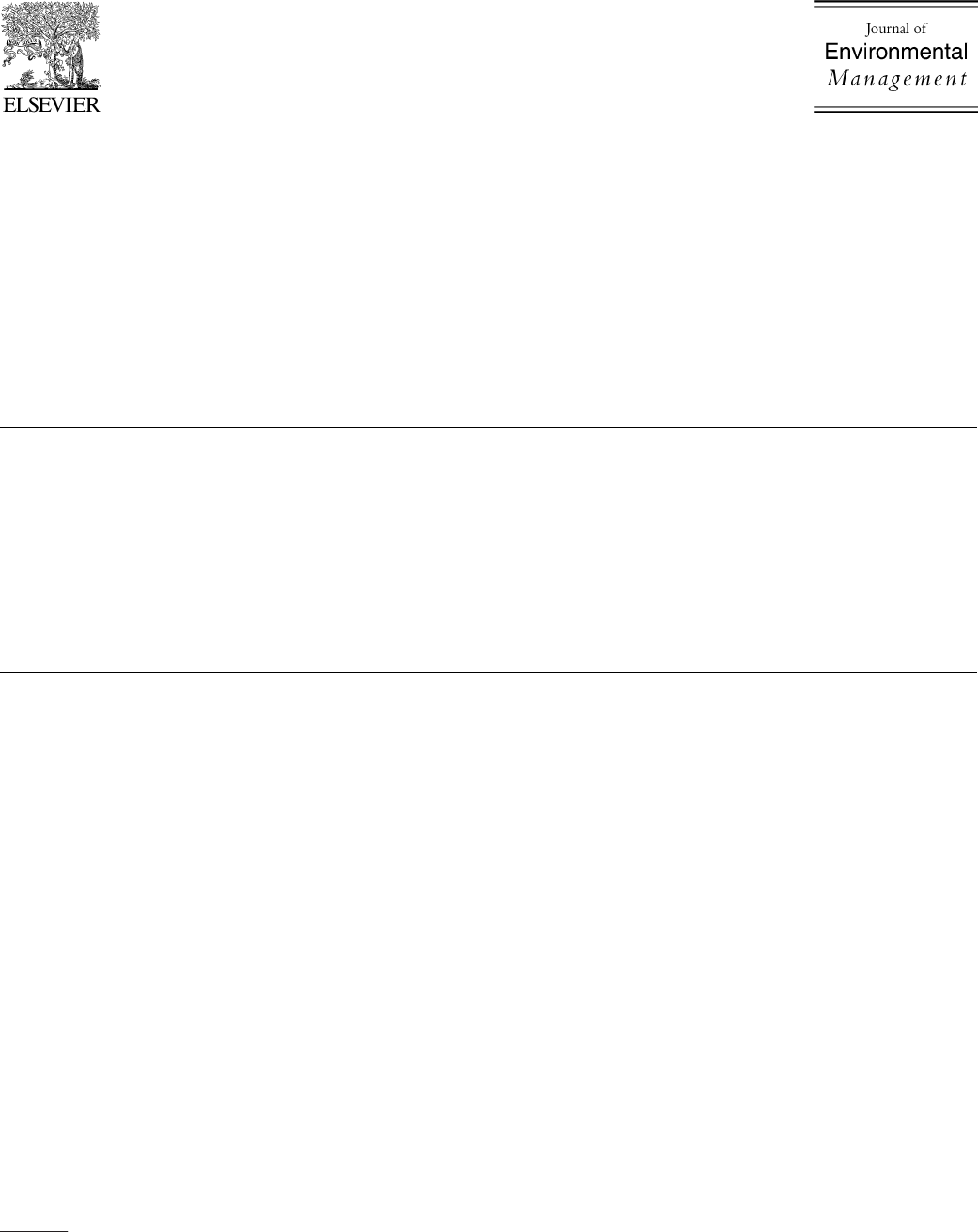
Application of a system dynamics approach for assessment and mitigation
of CO
2
emissions from the cement industry
Shalini Anand
a,
*
, Prem Vrat
b
, R.P. Dahiya
a
a
Centre for Energy Studies, Indian Institute of Technology Delhi, Hauz Khas, New Delhi 110016, India
b
Indian Institute of Technology Roorkee, Uttranchal-247667, India
Received 21 August 2003; revised 2 August 2005; accepted 3 August 2005
Available online 22 November 2005
Abstract
A system dynamics model based on the dynamic interactions among a number of system components is developed to estimate CO
2
emissions
from the cement industry in India. The CO
2
emissions are projected to reach 396.89 million tonnes by the year 2020 if the existing cement making
technological options are followed. Policy options of population growth stabilisation, energy conservation and structural management in cement
manufacturing processes are incorporated for developing the CO
2
mitigation scenarios. A 42% reduction in the CO
2
emissions can be achieved in
the year 2020 based on an integrated mitigation scenario. Indirect CO
2
emissions from the transport of raw materials to the cement plants and
finished product to market are also estimated.
q 2005 Elsevier Ltd. All rights reserved.
Keywords: Cement industry; CO2 emissions; Greenhouse gases; Mitigation options; System dynamics
1. Introduction
Energy use in the industrial sector is responsible for
approximately one third of the global carbon dioxide (CO
2
)
emissions. In India, six industries have been identified as
energy-intensive, viz: aluminium, cement, fertilizer, iron and
steel, glass, and paper (Schumacher and Sathaye, 1999). The
cement sector holds a considerable share within these energy-
intensive industries. The CO
2
emissions from cement plants are
next only to the coal based thermal power plants. On the global
scale the cement industry is responsible for 20% of the man-
made CO
2
emissions. This contributes to around 10% of the
man-made global warming potential.
In cement making, nearly half of the carbon dioxide
emissions result from energy use and the other half from the
decomposition of calcium carbonate during clinker production
(Hendriks et al., 1999). Moreover, the transport of raw
materials and finished products indirectly contributes to the
share of CO
2
emission from the cement industry.
At present, the Indian cement industry produces 13 different
types of cement; out of which Ordinary Portland Cement
(OPC), Portland Pozzolana Cement (PPC) and Portland Slag
Cement (PSC) together constitute 99%. Two cement varieties
are in use, white and grey. OPC consists of 95% clinker and 5%
gypsum. PPC consists of 65% clinker, 5% gypsum and 30%
pozzolana. Pozzolana materials include volcanic ash, power-
station fly ash, burnt clays, ash from burnt plant material and
silicious earths. Pozzolana has siliceous (SiO
2
) and aluminous
(Al
2
O
3
) materials that do not possess cementing properties but
develop these properties in the presence of water. It has a lower
heat of hydration, which h elps in preventing cracks where large
volumes are being cast. PSC consists of 30% clinker, 5%
gypsum and 65% slag. It has a heat of hydration even lower
than that of PPC and is generally used in the construction of
dams and similar massive structures (Worrell et al., 1995;
Karwa et al., 1998).
Limestone is a major raw material used in the production of
cement. It is burnt to make clinker and is blended with
additives. The finished product is then finely grounded to
produce different types of cement (World Energy Counci l,
1995; Schumacher and Sathaye, 1999). Additives used are
mainly fly ash from coal-fired thermal power plants, slag from
blast furnaces in the iron and steel industry, pozzolana and
natural zeolites. Natural zeolite contains large quantities of
reactive SiO
2
and Al
2
O
3
. Zeolite substitution can improve the
strength of concr ete by the pozzolanic reaction with Ca(OH)
2
.
This is a reaction in the presence of lime (calcium oxide, CaO)
and water to produce reaction products that are cementitious in
nature.
Journal of Environmental Management 79 (2006) 383–398
www.elsevier.com/locate/jenvman
0301-4797/$ - see front matter q 2005 Elsevier Ltd. All rights reserved.
doi:10.1016/j.jenvman.2005.08.007
*
Corresponding author.
In the cement production process around 0.97 tonne of CO
2
is produced for each tonne of clinker produc ed. Its distribution
is mainly from calcination (0.54 tonne), use of coal and fossil
fuels (0.34 tonne) and electricity generation (0.09 tonne)
(Marchal, 2001). On an average, around 900 kg of clinker is
used in each 1000 kg of cement produced. Thus each tonne of
cement is associated with 0.873 tonne of CO
2
emissions
(CE MBUREAU, 1996, 1998, 1999; International Energy
Agency, 1999; McCaffrey, 2001).
While working out the need for cement production in the
coming years, various policy options should be explored
keeping in view their environmental aspects. Implications of
the policy options and the associated dynamics of CO
2
emissions from the cement industry can be analysed using a
System Dynamics (SD) approach. In this dynamic simulation
approach information governing the interactions in a system is
fed via interactive feedback loops.
In management and social systems, policy-makers and
researchers have extensively used SD methodology and
conducted policy experiments (Mohapatra et al., 1994). The
SD approach has also been applied to a number of studies
related to the environment; environmental impact assessment
analysis (Vizayakumar and Mohapatra, 1991, 1993), solid
waste management (Mashayekhi, 1993; Karavezyris et al.,
2002), analysis of greenhouse gas emissions and global
warming (Naill et al., 1992; Vrat et al., 1993), investigations
of methane emissions from rice cultivation in the Indian
context (Anand et al., 2005), water resource planning (Ford,
1996), environmental planning and management (Guo et al.,
2001; Guneralp and Barlas, 2003), environmental sustain-
ability (Saysel et al., 2002), ecological modeling (Wu et al.,
1993) and many mor e situations. Though the SD model deals
with a system in an integrated sense, the system is decomposed
by dividing it into a number of interacting subsystems. The
individual subsystems can then be analysed and integrated
keeping the mutual interactions among the subsystems.
In this paper we have adopted the System Dynamics
methodology for assessment and mitigation of CO
2
emissions
from the cement industry in India. The projections of cement
production are considered to be mainly influenced by the
population growth, the gross domestic product (GDP)
increment rate and technologies employed in the cement
industry. A software package ‘Powersim’, which is available
for system dynamics analysis has been used in developing a
model for the cement sector. The proposed model is a
combination of spreadsheet (excel) and system dynamics
modeling framework. By interfacing the two the capabilities of
both are mutually reinforced, as there is dynamic exchange of
data during the course of simulation. Use of a spreadsheet gives
the flexibility of manipulating some of the data before it is fed
into the system dynamics model, thus enhancing the scope of
policy experimentation.
2. System dynamics model for cement sector
In a system dynamics model, the simulations are essentially
time-step simulations. The model takes a number of simulation
steps along the time axis (Anand et al., 2005). The dynamics of
the system are represented by d N(t)/dtZkN(t), which has a
solution N(t)ZN
0
expt(kt). Here, N
0
is the initial value of the
system variable, k is a rate constant (which affects the state of
the system) and t is the simulation time. For the simulations to
start for the first time, initial values of the system variables are
needed.
2.1. Causal loop diagram
The SD model for the present studies was developed for
scenario building, conducting policy experiments and making
projections for CO
2
emissions. A causal loop diagram, shown
in Fig. 1, was developed by incorporating the various features
associated with the cement sector. A flow diagram was then
created from the causal loop diagram and dynamo equations for
each element in the diagram were added in the model. The
model so evolved was run for a period of 20 years starting from
the baseline year 2000.
The mutual interactions associated with cement production
and the related CO
2
emissions are qualitatively expressed in the
causal loop diagram. Dynamics of the model are determined by
the feedback loops of the causal loop diagram. Each arrow of
the causal loop diagram indicates the influence of one element
on the other. The influence is considered positive ( C )ifan
increase in one element causes an increase in another, or
negative (K) in the opposite case. The causal loop diagram is
self-explanatory.
2.2. Flow diagram
A flow diagram is useful for showing the physical and
information flows in the SD model. Fig. 2a–e show the details
of the flow diagram developed for anal ysing the cement sector.
Intricacies of the mutually interacting processes are delineated
in the flow diagram.
The level variables are shown as rectangular boxes which
represent accumulated flows to that level. A double arrow
represents the physical flows, and the flow is controlled by
a flow rate. A single line is for showing information flow.
Source and sink of the structure are represented by a cloud.
The cloud symbol indicates infinity and marks the boundary
of the model.
Once the simulation is over, at the end of each step,
system variables are brought up to date for representing the
results from the previous simulation step. The rate variables
are represented by valves. The information from the level
variables to the rate variables is transformed by a third
variable called the auxiliary variable, represented by circles.
The diamonds represent constants, which do not vary over
the run period of simulation. A constant is defined by an
initial value throughout the simul ation. To avoid messing up
and criss-crossing in the diagram the variables repeated in
the diagram are represent ed in the form of snapshot
variables (frame-like structures).
Five subsystems corresponding to different scenarios are
built and discussed in the following sections:
S. Anand et al. / Journal of Environmental Management 79 (2006) 383–398384
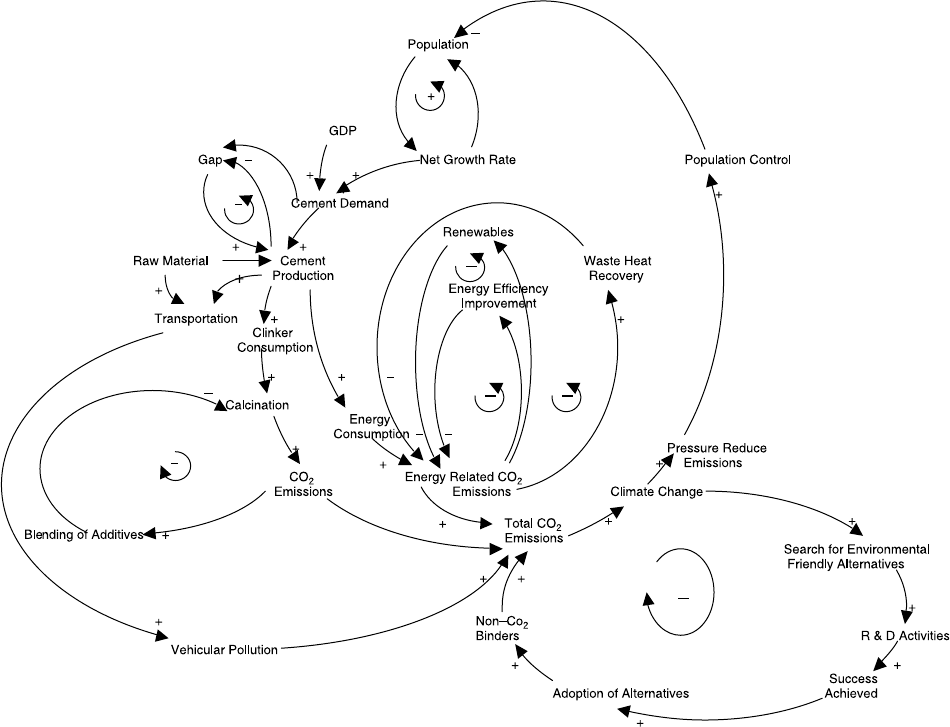
2.2.1. demand and production
Cement demand and production are taken as level variables.
The cement demand represented in Fig. 2(a) would increase with
the growth of population and the gross domestic product (GDP).
Production should follow the demand and the CO
2
emissions
from the plants would likewise increase with more production.
This requires information about population, and the population is
then considered as a level variable. Its variation obviously
depends on the rate of population growth. Percent share of
different varieties of cement are worked out and accordingly the
clinker consumed in cement production is estimated. Since
changes in population growth rate, cement production rate, and
percent share of blended cement affect the rate of CO
2
emissions
from the cement industry, the impact of these changes is tested
using an additional auxiliary named ‘switch’. The user can adjust
its value to select one of the possible options.
The dynamo equations used to account for the baseline
scenario (BS), scenarios 1 and 2 (S1 and S2) in this
subsystem are
Population Z Population C dt
!Population_growth_rate (1)
where
Population_growth_rate Z Population!Condi-
tional_population_-
growth_rate_multiplier
Conditional_population
_growth_rate_multiplier Z IF(Switch_AZ 1,
Population_growth_-
multiplier_BS, IF(Swi-
tcha _AZ 2,Popul-
tion_growth_multiplier
_S1,Population_gro-
wth_multiplier_S2))
Population_growth_multiplier_BS Z0.016CSTEP
(K.0003,2001)CSTEP
(K.0007,C2006 )C
STEP(K.0006,C2011)
Population_growth_multiplier_S1 Z GRAPH(TIME,
2000,1,[0.0162,0.0157,
0.0157,0.0148,0.0139,
0.013,0.0121,0. 0112,
0.0103,0.0094,0.0085,
0.0076,0.0067,0.0058,
0.0049,0.004,0. 0031,
0.0022,0.0013,0 ,
0”Min:0;Max:0.02”])
Fig. 1. Causal—loop diagram of the system dynamics model for cement sector.
S. Anand et al. / Journal of Environmental Management 79 (2006) 383–398 385
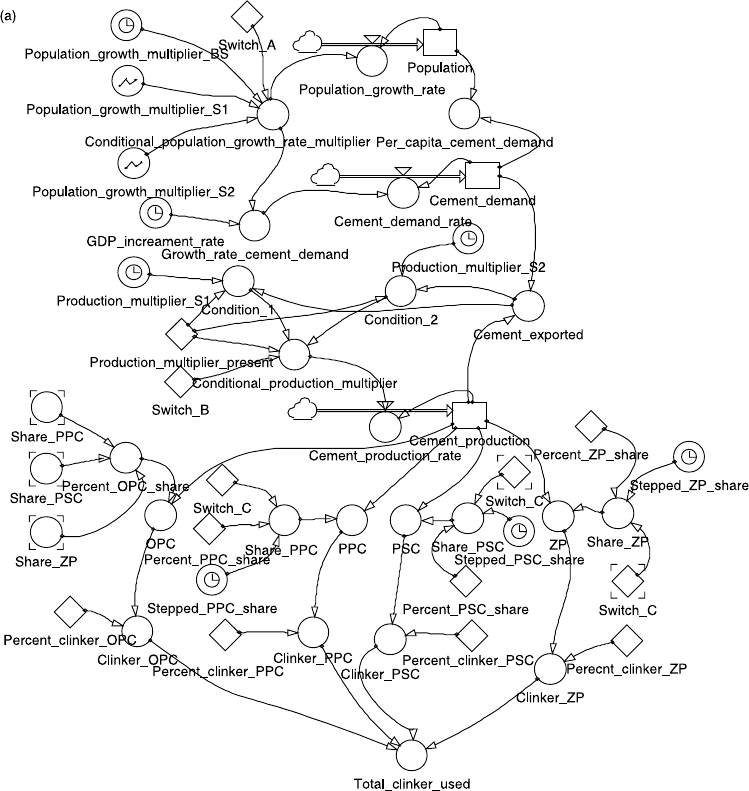
Population_growth_multiplier_S2 Z GRAPH(TIME,
2000,1,[0.0162,0.0157,
0.0157,0.0138,0.0119,
0.01,0.0081,0.0 062,
0.0043,0.0024,0.0005,
0,0,0,0,0,0,0,0 ,0,
0”Min:0;Max:0.02”])
For cement demand and production the dynamo
equations used in the model are as follows:
Cement_demand
Z Cement_demand C dt!Cement_demand_rate (2)
where
Cement_demand_rate ZGrowth_rate_cement
_demand!Cement_de-
mand
Growth_rate_cement_demand ZGDP_increament_ra-
teCConditional_popu-
lation_growth
rate_multiplier
and, therefore, cement demand can be expressed as
Cement_demand
Z Cement_demand C dt!fðGDP_increament_rate
C Conditional_population_growth_rate_multiplierÞ
!ðCement_demand_rateÞg (3)
Now,
Fig. 2. Flow diagrams of the system dynamics model for cement sector. Subsystem diagrams are labeled as Figs. a–e. Fig. 2 (a) Subsystem depicting the interactions
among population, cement demand, cement production and total clinker used. (b) Subsystem for evaluating the electric and thermal energy consumption and total
CO
2
emissions. (c) Subsystem for incorporating the coal consumption, fly ash production, pig iron production and slag availability. (d) Subsystem for estimating CO
2
emissions from transport of raw materials (limestone and coal) from their mines to the cement plants. (e) Subsystem for estimating CO
2
emissions due to the
transport of cement to market.
S. Anand et al. / Journal of Environmental Management 79 (2006) 383–398386
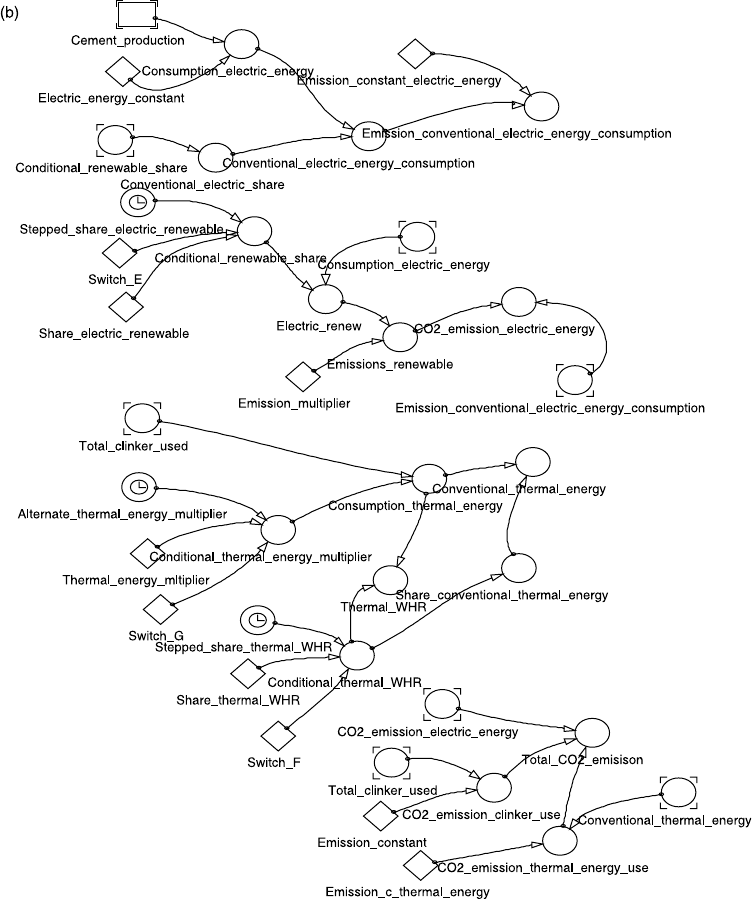
Cement_production
Z Cement_production C dt
!Cement_production_rate (4)
Cement_exported
Z Cemnent_productionKCement_demand (5)
where,
Cement_production_rate Z Cemen t_produc-
tion!Conditional_pro-
duction_multiplier
Conditional_production
_multiplier Z IF(Switch_BZ 1,
Production_multiplier_
present, IF(Switch_BZ
2, Condition_1,
Condition_2))
Condition_1 ZIF(Cement_exported
O0, Production_multi-
plier_S1, Production_-
multiplier_present)
Condition_2 ZIF(Cement_exported
O0, Production_multi-
plier_S2, Production
_multiplier_present
Fig. 2 (continued)
S. Anand et al. / Journal of Environmental Management 79 (2006) 383–398 387
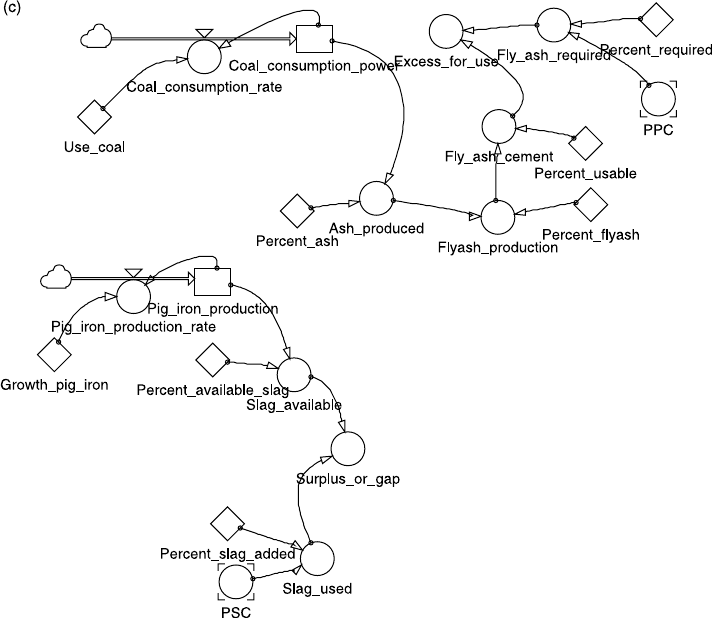
where the production_multiplier_present is for the base-
line scenario.
Similarly, the dynamo equations were written for energy
consumption, availability of slag and fly ash, CO
2
emissions
from cement plants and CO
2
emissions arising from transport
requirements.
2.2.2. Energy consumption
Electric energy consumption for the cement industry is
estimated by considering the electric energy consumed per
tonne of cement produced. Its flow diagram is shown in Fig. 2
(b). For the various policy options it is bifurcated into the
conventional electric energy and electric energy from renew-
ables. The share of these is varied by a switch function for
alternate scenarios. Similarly, the thermal energy consumption
is estimated by taking into account the thermal energy
consumed per tonne of clinker used. Scenarios considering
improved thermal energy efficiency and waste heat recovery
are also evaluated under this head.
2.2.3. Avalability of slag and fly ash
The flow diagram shown in Fig. 2 (c) is used to estimate the
availability of the blending materials, i.e. slag, fly ash and
zeolite. Coal consumption for power generation, taken as a
level variable, is calculated and projected for a span of 20
years. For estimating the availability of fly ash it is assumed
that on an average the Indian coal has 33% ash content (Mehra
and Damoda ran, 1993; Choudhary and Bhakatvatsalam, 1997;
www.cea-in/opt7-vidyut-chap4.html). Out of this 80% comes
out as fly ash during coal combustion in thermal power plants.
Approximately, 50% of the wet fly ash disposed in the ash
ponds is suited for cement making (Worrell et al., 1995) and
the dried fly ash can be lifted from the ash ponds.
Slag is produced in the blast furnace of pig iron plants. In
this process 0.7 tonne of slag is gener ated per tonne of pig iron
produced (Worrell et al., 1995).
2.2.4. CO
2
emissions from cement plants
Total CO
2
emissions from cement plants are estimated as
the sum total of CO
2
emissions from the consumption of
clinker in the process of thermal energy production and
generation of electric energy required for the plants. Policy
options are implemented while working out the scenarios for
the mitigation of total CO
2
emissions over a period of time.
Total CO
2
emissions
Z CO
2
_emission_clinker_use
C CO
2
_emission_electric_energy use
C CO
2
_emission_thermal_energy_use (6)
In the mixed mode of production the total clinker used is
taken in additive mode
Fig. 2 (continued)
S. Anand et al. / Journal of Environmental Management 79 (2006) 383–398388
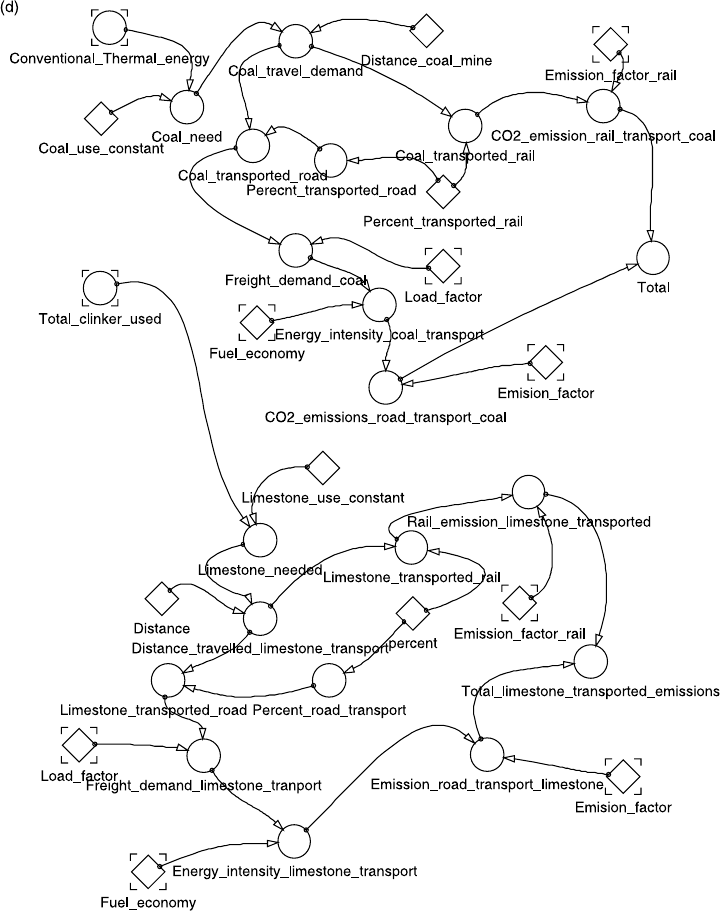
Total_clinker_used
Z Clinker_OPC C Clinker_PPC C Clinker_PSC
C Clinker_ZP (7)
where
Clinker_OPC Z Cement_production
!Percent_OPC_share
Clinker_PPC Z Ce ment_production
!Share_PPC
Clinker_PSC Z Ce ment_production
!Share_PSC
Clinker_ZP Z Ce ment_production
!Share_ZP.
2.2.5. CO
2
emissions arising from transport requirements
Cement production requires transportation of raw materials
(limestone and coal) to the cement plants. The finished product,
cement, is eventually transported to the user market.
Transportation is associated with vehicular emissions, which
adds to the CO
2
emissions.
Fig. 2 and e represent the respective flow diagrams
associated with the CO
2
emissions from the transport of raw
materials, limestone and coal to the cement industry and that of
cement to the market. The quantit y of coal needed for the
cement industry is calculated on the basis of thermal energy
consumed per tonne of clinker used. Similarly, the calculation
is made for limestone needed for clinker production. The
respective shares of the rail and road transportation are taken as
55 and 45%. For the rail transported raw materials, the CO
2
emissions are calculated using the emission factor given by
Fig. 2 (continued)
S. Anand et al. / Journal of Environmental Management 79 (2006) 383–398 389
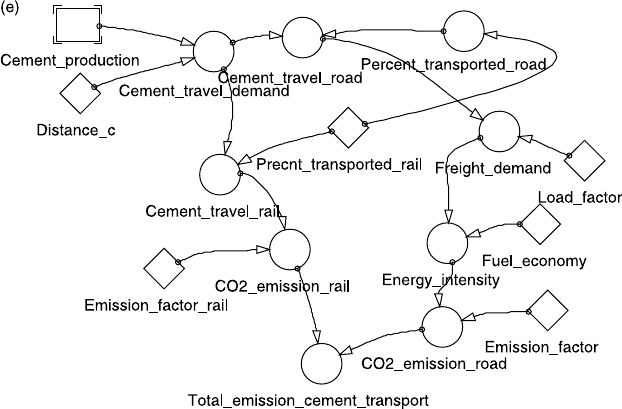
IPCC. In the case of the road transport, the energy intensity is
calculated from the load factor and the fuel economy. The CO
2
emissions from transportation of raw material and the finished
product, cement, are then obtaine d using the emission factors
0.03 kg CO
2
per tonne kilometer for rail transport and 2.74 kg
CO
2
per liter of diesel for road transport. Fuel economy is 3 km
per liter and the load factor is 5 tonne kilometer per vehicle
kilometer for road transport. This gives 0.183 kg CO
2
per tonne
kilometer emission if the road freight is used (GHG Protocol
-Mobile Guide, 2001).
3. Scenario generation
Three scenarios are generated under the broad categories of
baseline scenario (BS) and modified scenarios 1 and 2 (S1 and
S2). Policy options based on structural management and energy
efficiency management are implemented in all three scenarios.
The model is run for a span of 20 years starting from the
baseline year 2000. Data for the population of India and its
growth rate are taken from the official figures (GOI, 1997,
2001, 2002).
3.1. Baseline scenario
This scenario is generated for the existing growth rate of the
population in the baseline year 2000 without any policy
interventions. The energy consumed, the amount of clinker
required and the quantity of CO
2
emitted in the process of
cement production are calculated at yearly intervals. In the year
2000, India’s population was 1014 million and had a growth
rate of 1.62%. For analysing various alternatives, a STEP
function is utilized. Using the population growth rates given in
the Ninth Five Year Plan of India the step sizes are taken as
1.57% from 2001 to 2006, 1.50% from 2006 to 2011 and 1.44%
beyond 2011 till 2018. Similarly, the growth rate of the gross
domestic product (GDP) is taken as 6% and is stepped up to 8%
(GOI, 1997, 2001–2002). As mentioned earlier, the population
growth and GDP would have additive effects on the cement
demand.
Cement production in India for the year 2000 was 100.4
million tonnes and from the historical trend this seems to
increase at a rate of 8.28%. Of the total cement produced, the
share of OPC is 67.19%, PPC is 22% and PSC is 11%. Trends
of CO
2
emissions are evaluated from the consumption of
clinker, thermal energy and electric energy in the process of
cement making. It is assumed that in making one tonne of
cement 110 GWh of electric energy and 3.4 Gj of thermal
energy are consumed in the dry process technology CII (1995)
and TEDDY (2000/2001). In the recent advanced energy
efficient systems 2.9 GJ is consumed per tonne. We have
accounted for this in the policy options.
Estimates are made for the availability of fly ash and blast
furnace slag in India. The projections of coal consumption in
thermal power plants and the pig iron production in steel
making are utilised for the estimates. Availability of the
blending materials is evaluated from the projections. These
projected trends are used as feedback for making modifications
in the structural composition of cement and (reduced) CO
2
emissions are calculated.
3.2. Modified scenarios
Population growth rate was chosen to build two modified
scenarios. In scenario 1 (S1) the population growth rate is
assumed to reach zero in the year 2020 and beyond, whereas in
scenario 2 (S2) the population is assumed to stabilise by the
year 2011.
The cement demand and production in these scenarios are
balanced by appropriately stepping down the rate of cement
production. Moreover, various technological policy options
based on energy management, structural management and a
combination of them are evaluated for the baseline and
Fig. 2 (continued)
S. Anand et al. / Journal of Environmental Management 79 (2006) 383–398390
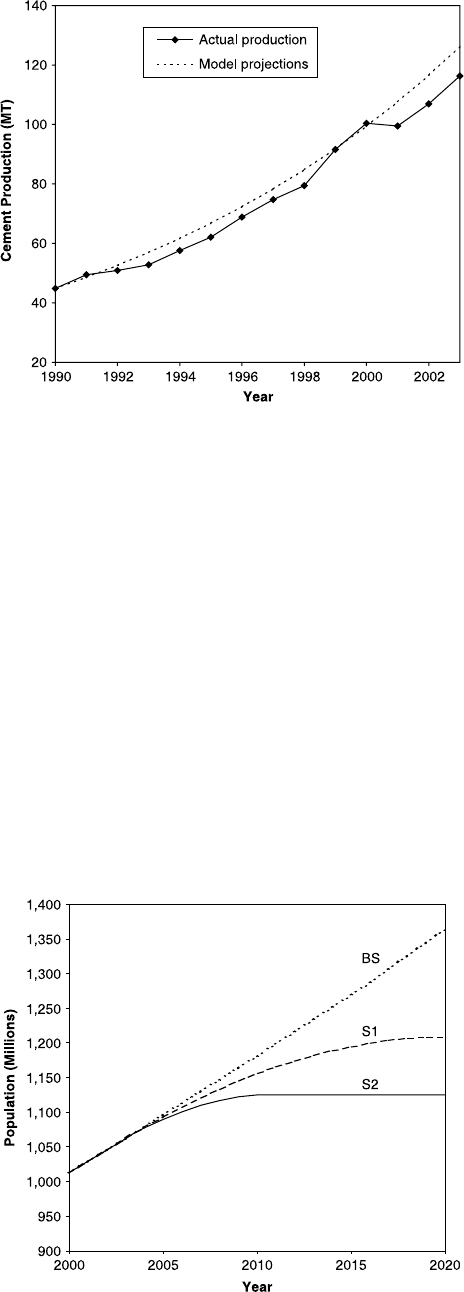
modified scenarios. The alternate policy options are made
effective from the year 2006 except for the renewable energy
option, which is incorporated from the year 2010.
Four sub parts are associated with the energy management
scenario, i.e. use of renewable energy, waste heat recovery,
improved specific energy consumption and a combination of
all three of them. Specifically, the quantitative estimates
adopted in our model are as follows:
(a) 25% of the electric energy require d in cement plants is
obtained from the renewable energy resources. This is not
yet possible and is, therefore, implemented from the year
2010.
(b) The specific energy consumption (SEC) in Indian cement
plants is 3.06 – 3.4 Gj/tonne, while in the advanced
energy efficient plants it is as low as 2.9 Gj/tonne (Somani
and Kothari, 1997; Schumacher and Sathaye, 1999; Price
et al., 2000; Khurana et al., 2002). Therefore, the model is
also run for the increas ed thermal energy efficiency up to
2.9 Gj/tonne of clinker produced.
(c) A scena rio is generated where 30% of the thermal energy
used is obtained from waste heat recovery.
(d) A combination of all the above-mentioned options is
worked out.
The model is run for each of these options separately under
the BS, S1 and S2 scenarios.
In the structural management scenario, the share of blended
cement is increased keeping in view the availability of
blending material. A scenario is generated taking into account
the production of 37% OPC, 45% PPC, 16% PSC and 2%
zeolite blended Portland cement.
Indirect CO
2
emissions resulting from the transportation of
raw materials and the finished product are also considered for
all the scenarios. We have taken the typical distance between
the coalmines and cement industry as 1500 km, between the
limestone mines and the cement industry as 200 km and
between the cement industry and the user market as 250 km.
Further, it is assumed that 55% of the raw materials and
finished products are t ransported by rail and 45% are
transported by road. These are tentative figures to determine
the trends using the SD approach. Realistic figures could vary
depending on the siting of the plants in the time to come.
4. Model validation
Confidence in the SD model for the system under study is
established through its validation on the basis of the data
utilized. The validation is carried out under three categories,
viz. historical validation of the data, a structural verification
test and a dimensional consistency test.
For the historical validation the cement production
variable is selected. Data for the year 1990 is incorporated
in the model and projections are made up to the year 2003.
The model results give good agreement with the actual
values, as is shown in Fig. 3. Points representing the actual
and model values of cement production show an overall
increasing trend. However, in the year 2000–2001, actual
annual production was negative. The fall in growth rate is
attributed to a recession in the demand (IIC, 2002), which
subsequently attained a positive growth.
The structural validation tests are applied at every stage of
the model building process to detect any structural flaws in the
model. These tests were, therefore, made simultaneously
throughout the model building process. Initially, the model
projected total population keeping the present rates of
population growth and then switched over to the zero
population growth rates by the years 2020 and 2011 for the
population stabilisation scenarios S1 and S2 respectively. This
is verified in Fig. 4 from the results obtained by running the
model.
Fig. 4. Projections for population of India under the baseline scenario (BS),
scenario 1 (S1) and scenario 2 (S2).
Fig. 3. Comparison of the quantity of cement production with the model
projections.
S. Anand et al. / Journal of Environmental Management 79 (2006) 383–398 391
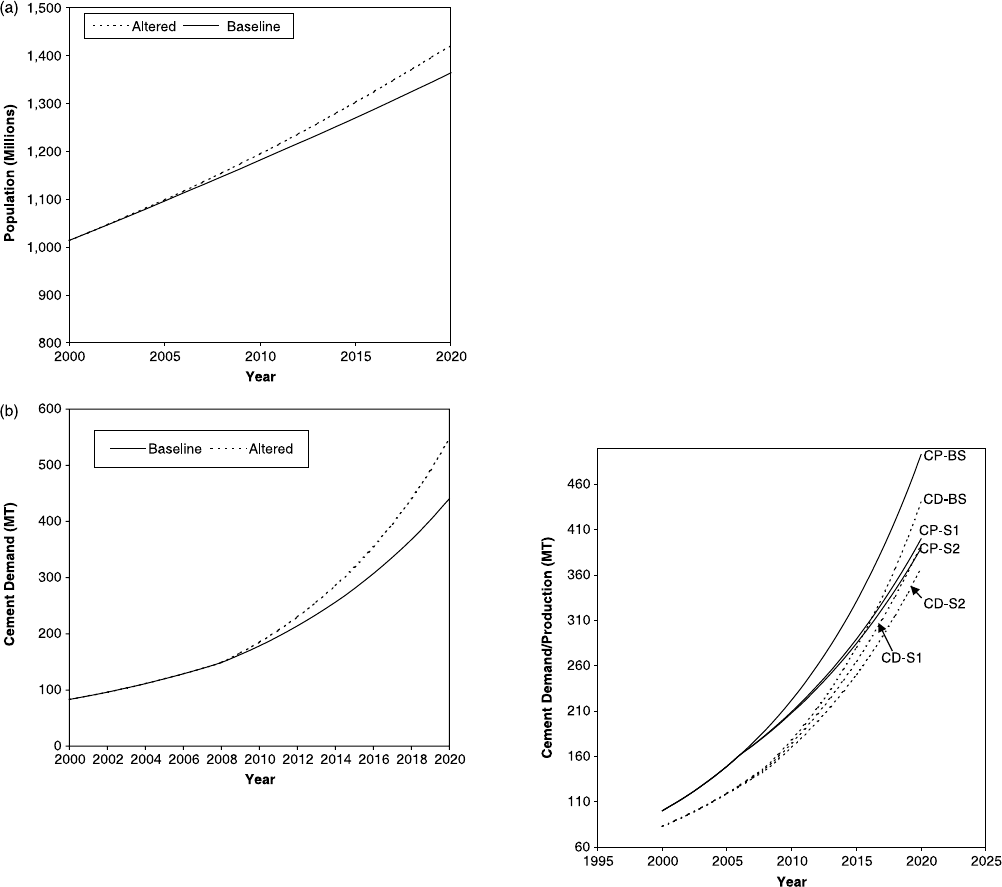
5. Sensitivity analysis
Sensitivity tests basically ascertain whether or not minor shifts
in the model parameters can cause shift in the behaviour of the
model. Once the robustness of the model is ensured, the model
can be used for policy making (Forrester, 1961; Mohapatra et al.,
1994). As already discussed, the emissions of CO
2
from the
cement industry are dependent on population, GDP, cement
demand and production. The sensitivity of the model to these
parameters is described in the following sections:
5.1. Impact of population on cement demand
Population is considered to play an important role in
controlling the cement demand, which in turn is the prime
determinant for the production of cement and the ultimate CO
2
emissions from the cement plants. It is evident from Fig. 5 (a)
that the population of the country would rise to 1421.80 million
from the projected figure of 1364.50 million, by the year 2020.
These calculations are made by changing the population
growth rate multipliers from 1.57, 1.50 and 1.44 to 1.63%, 1.7
and 1.76% for the years 2001–2006, 2006–2011 and 2011–
2018, respectively.
5.2. Impact of GDP on cement demand
The impact of GDP enhancement on cement demand is tested
by raising the GDP to 0.1 from 0.08 for the years 2008 onwards.
Fig. 5(b) shows the baseline and the altered curves. A small
increase in GDP does contribute to the increased cement demand.
The model is thus sensitive to minor shifts in the parameters
ensuring its clearance of the sensitivity test.
6. Results and discussion
The results obtained for different scenarios developed in the
SD model are discussed to ascertain the impacts of various
policy options on CO
2
emissions from the cement industry in
India. Trends are evaluated for a 20 year span starting from the
year 2000.
6.1. Baseline scenario
The rates of population growth and GDP as applicable in the
year 2000 (GOI, 1997, 2001–2002) were kept constant for
working out the baseline scenarios. The tec hnology employed
in making cement was also kept unaltered. Using these options,
India’s population is projected to reach 1364.50 million by the
year 2020. Fig. 4 shows the population growth for the baseline
(BS) and scenarios S1 and S2. The cement demand and cement
production are shown in Fig. 6. Cement demand projected for
Fig. 6. Projections for cement demand (CD) and cement production (CP) for the
baseline scenario (BS), scenario 1 (S1) and scenario 2 (S2).
Fig. 5. Sensitivity of the model to the different parameters. (a) Impact of
population growth rate multiplier on population. The population growth rate
multiplier is changed from 1.57, 1.50 and 1.44% to 1.63, 1.7 and 1.76% for the
years 2001–2006, 2006–2011 and 2011–2018, respectively, for obtaining the
altered scenarios and (b) variation in cement demand with gross domestic
product (GDP). The GDP is raised to 0.1 from 0.08 for the years 2008 onwards
for obtaining the altered scenarios.
S. Anand et al. / Journal of Environmental Management 79 (2006) 383–398392
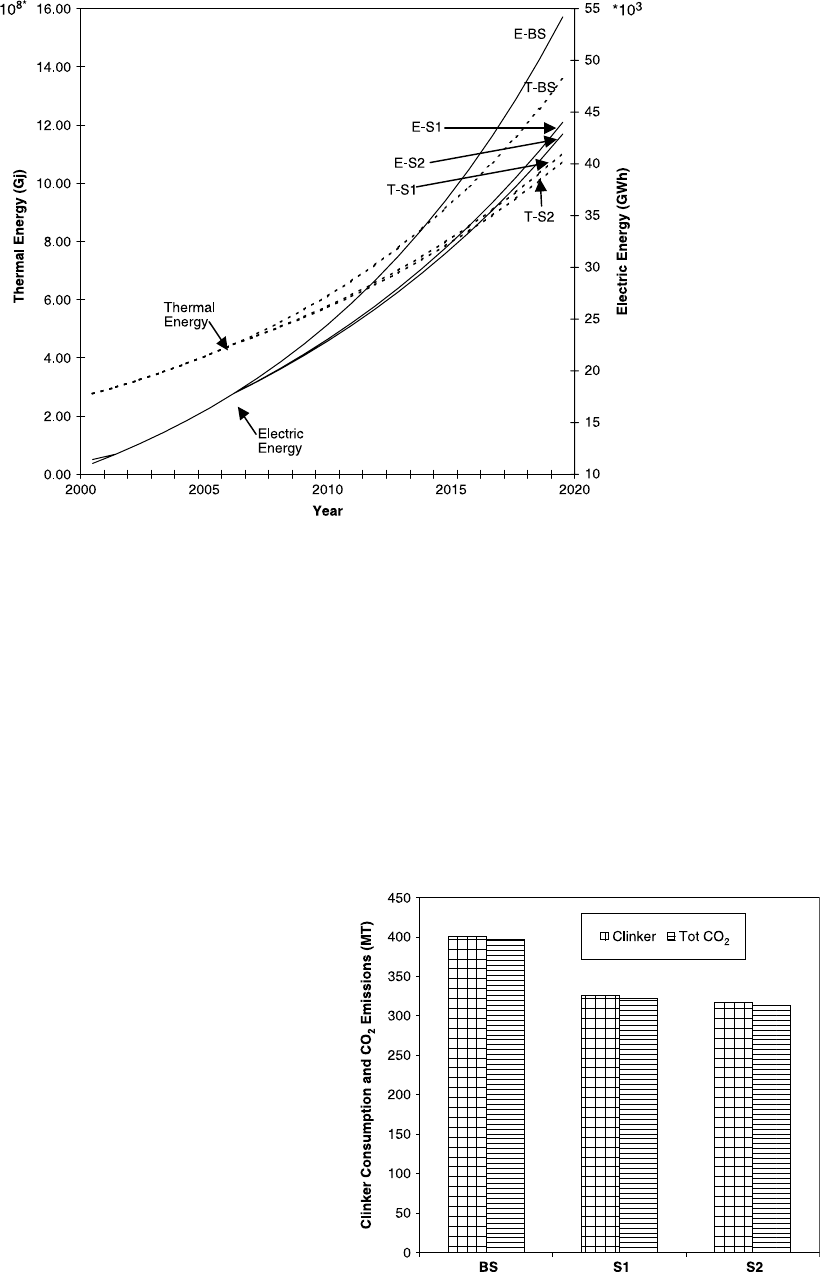
the year 2011 by our model is 195.50 million tones, and this is
comparable to that of Schumacher and Sathaye (1999) (200.5
million tones). The cement production is projected to reach
492.83 million tonnes by the year 2020 with 331.13 million
tonnes of OPC, 108.18 million tonnes of PPC and 53.52 million
tones of PSC. The clinker requirement will be 400.95 million
tonnes with respective shares of 314.58 million tonnes for
OPC, 70.31 million tonnes for PPC and 16.06 million tonnes
for PSC.
For the baseline scenarios the model has predicted that in
the year 2020, 13.5 9!10
8
Gj of thermal energy and
54211.49 GWh of electric energy will be required in the
making of cement. The respective CO
2
emissions will then be
135.92, 44.45 and 216.51 million tonnes from thermal energy
consumption, electric energy consumption and clinker con-
sumption. Figs. 7 and 8 show the annual growth of energy
utilization, clinker consumption and total CO
2
emissions,
respectively, for the BS and modified scenarios S1 and S2.
The direct CO
2
emissions are estimated to increase from
80.85 million tonnes in the year 2000–396.88 million tonnes in
20 years.
6.2. Modified scenarios
The cement demand and production are obviously linked to
the population growth, economic activity in the country, the
level and growth of GDP and the level of urbanization. Control
of the population growth can be one of the options for
mitigating the CO
2
emissions. As mentioned earlier, we have
analysed two scenarios. In scenario 1 the growth rate for
population is brought to zero by the year 2020 (S1) and in the
scenario 2 (S2) a faster decline in the growth rate is analysed
where zero growth rate is achieved in the year 2011.
Fig. 4 shows that with the S1 scenario the population of
India would reach 1208.38 million in the year 2020. The
cement demand will then be 393.31 million tonnes, a reduction
of 10.67% from the base line scenario. This is shown in Fig. 6.
Since the cement production is linked to its demand, which in
turn is linked to popul ation growth, a reduction of 18.81% in
production is projected as compared to the baseline scenario.
To produce the require d quantity of cement (400.12 million
Fig. 7. Projections for thermal (T-BS, T-S1/S2) and electric (E-BS, E-S1/S2) energy consumption for the baseline scenario (BS), scenario 1 (S1) and scenario 2 (S2).
Fig. 8. Projections for clinker consumption for cement production and total
CO
2
emissions from the cement industry under the baseline scenario (BS),
scenario 1 (S1) and scenario 2 (S2) for the year 2020.
S. Anand et al. / Journal of Environmental Management 79 (2006) 383–398 393
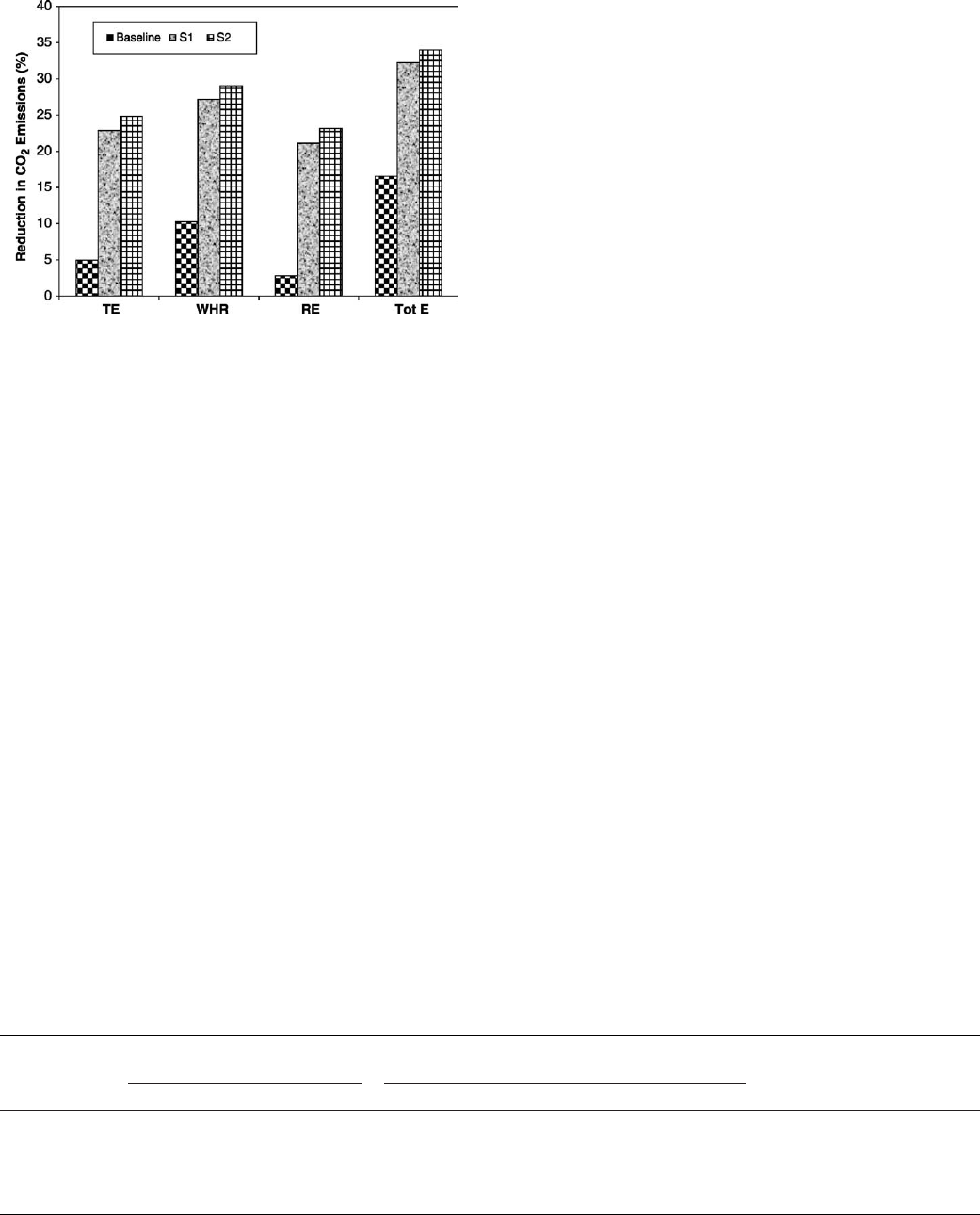
tonnes), the consumption of thermal energy will be 11.04!
10
8
Gj, electricity 44012.70 GWh (Fig. 7) and the clinker
requirement will be 325.52 million tonnes (Fig. 8). As shown in
Fig. 8, 322.22 million tonnes of CO2 will be emitted in the year
2020 from a combination of thermal energy consumption
(110.35 million tonnes) electricity consumption (36.09 million
tonnes) and clinker consumption (175.78 million tonnes). A
further decrease in all the parameters, shown in Fig. 6–8,
obviously occurred when we tried to stabalise the rate of
population growth to zero by the year 2011 (S2). With the
scenario S2 the popul ation would stabalise at 1125.30 million
by the year 2011 and, therefore, remain constant. A reduction
of 20.92% (389.74 million tonnes) in cement produc tion is
projected for the year 2020 when applying the S2 policy option.
Accordingly, the consumption of thermal energy will be
10.75!10
8
Gj, ele ctricity use will be 423871.48 GWh and
317.08 million tonnes of clinker will be required. The
corresponding CO
2
emissions will be 107.49 million tonnes
due to thermal energy consumption, 35.15 million tonnes from
electricity consumption, and 171.22 million tonnes in the
calcination process. In total a 20.92% (313.87 million tonnes)
reduction in direct CO
2
emissions will occur. When we reduce
the rate of population growth, a decrease obviously occurs in
the cement demand and produc tion. But, the decline in cement
demand does not follow the trend of population decrease, as the
cement demand is linked to the investment in the cement-
intensive infrastructure. India being a developing country such
an investment will increase.
6.2.1. Energy management scenario
Fig. 9 shows the outcome of the energy management policy
options for the BS and S1 and S2 scenarios. If 30% thermal
energy from the waste heat is taken into account, the CO
2
emissions would decline to 356.11, 289.12 and 281.62 million
tonnes for the BS, S1 and S2, respectively. The CO
2
emissions
would be substantially curtailed by meeting some of the
electric energy demand in the cement plants with renewable
energy. It is expec ted that the renewable energy resources will
play an important role in the years to come. For analyzing the
effect of renewable energy we have replaced 25% of the
electric energy supply to the cement plants with renewable
energy. This is incorporated from the year 2010 sinc e the
electric power generation from renewable energy resources is
expected to play a substantial role by that time. Reductions of
2.80% for BS, 21.09% for S1 and 23.13% for S2 in CO
2
are
projected under these conditions. It is worth mentioning here
that four cement plants in the Southern part of India have
already installed 80.25 MW (e) capacity wind power gen-
erators in their wind farms. Presently they feed their output into
the grid (www.cleantechindia.com/eicnew/cement.html).
Energy efficient clin ker making tech nology is now
available. When the improved specific energy consumption
of 2.9 Gj/tonne of clinker production in the plant for the best
practice technology (Schumacher and Sathaye, 1999; Price
et al., 2000) is considered, CO
2
emissions are reduced by 4.95,
22.83 and 24.83% for the BS, S1 and S2. Fig. 9 also shows the
percent reduc tions in theCO
2
emissions for an integrated
scenario where all the above-mentioned energy management
options are implemented simultaneously.
Fig. 9. Per cent reductions in CO
2
emissions from cement industry for the
energy efficiency improvement (EEI) scenarios; 25% contribution of electric
energy from the renewable sources of energy (RE) starting from the year 2010,
30% thermal energy recovery from waste heat (WHR), 2.9 Gj/tonne specific
energy consumption (T) is used in clinker processing and a combined scenario
taking all the above mentioned energy efficiency improvement scenarios (TotE).
The baseline scenario (BS), scenario 1 (S1) and scenario 2 (S2) are shown
separately.
Table 1
Projections of CO
2
emissions due to clinker consumption for increasing share of Ordinary Portland Cement (OPC), Portland Slag Cement (PSC) and Portland
Pozzolana Cement (PPC) for the baseline scenario
Year Availability of blending materials
(million tonnes)
Share of cement types (million tonnes) CO
2
emissions from clinker
consumption (million tonnes)
Fly ash Slag OPC PSC PPC
2000 28.15 15.91 67.46 10.90 22.04 44.11
2005 36.76 21.41 100.41 16.23 32.80 65.65
2010 48.00 28.81 149.46 24.16 48.83 97.72
2015 62.67 38.78 222.47 35.96 72.68 145.46
2020 81.83 52.19 331.13 53.52 108.18 216.51
WHR, Waste heat recovery; in this scenario 30% of the thermal energy is recovered from the waste heat. SM, Structural management; in this case the share of
blended cement is increased to 37% OPC, 45% PPC, 16% PSC and 2% ZP.BS, Baseline scenario. S1, Population growth is stabilised to zero by the year 2020. S2,
Population growth is stabilised to zero by the year 2011.The share of blended cements is ascertained from the availability of fly ash and slag.
S. Anand et al. / Journal of Environmental Management 79 (2006) 383–398394
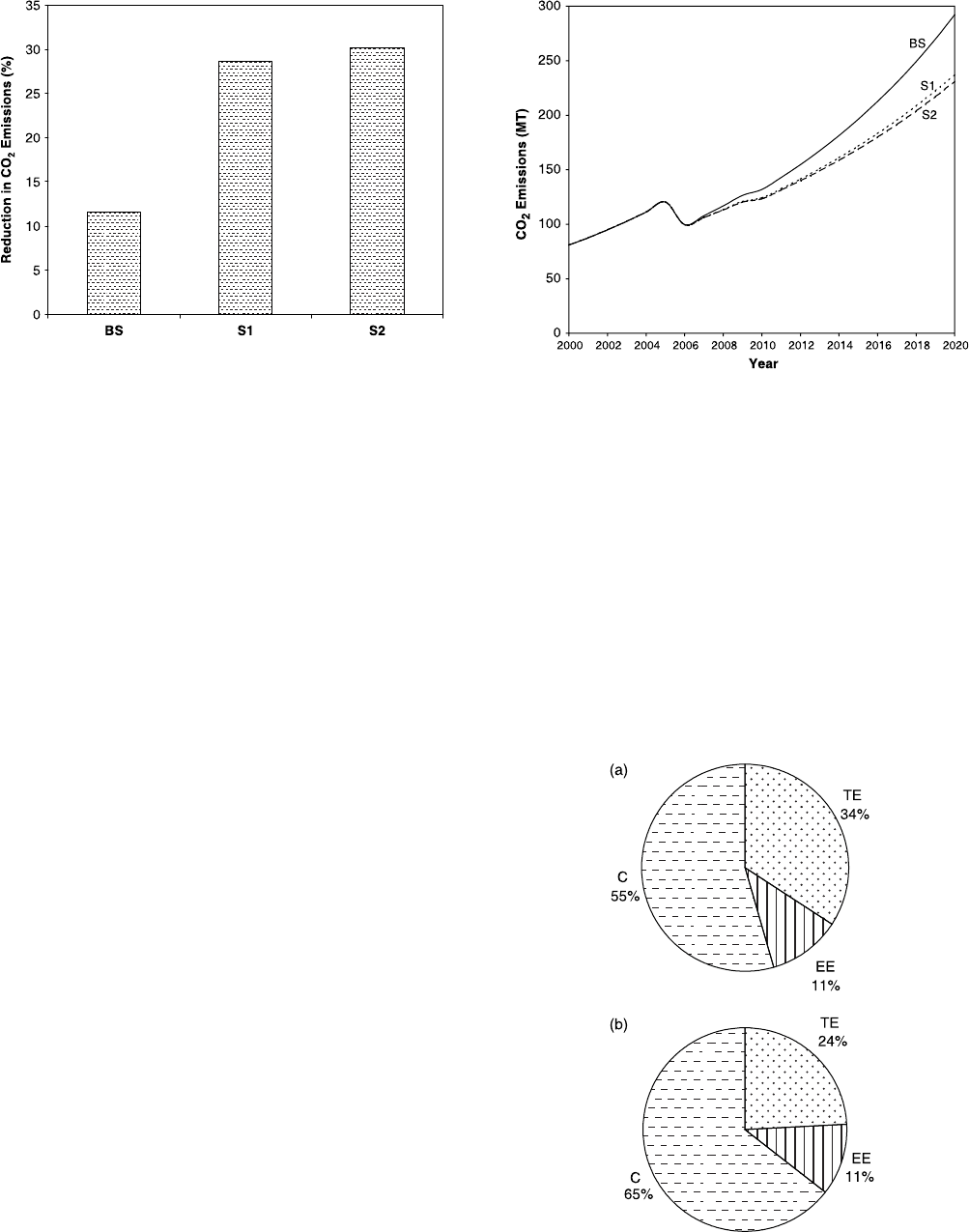
6.2.2. Structural management scenario
For the structural management scenario the share of PPC
has been increased to 45%, PSC to 16% and zeolite Portland to
2%. Availability of fly ash and blast furnace slag would restrict
the further increase of their share.
In India the coal consumption in thermal power plants was
234.6 million tonnes in the year 2000 and is projected to reach
681.92 million tonnes by the year 2020. Therefore, 28.15
million tonnes of fly ash was available for cement use in the
year 2000, but actually merely 6.61 million tonnes was utilized.
The fly ash demand in cement plants is projected to reach 66.53
million tonnes in the year 2020 and 81.83 million tonnes will
be available. Table 1 gives the projections of the availability of
blending materials and CO
2
emissions for structurally modified
cement production. Pig iron production in the iron and steel
industry was 20.5 million tonnes in the year 2000, thereby
generating 15.91 million tonnes of blast furnace slag. This iron
production would reach 67.25 million tonnes in the year 2020
generating 52.19 million tonnes of furnace slag. With the
presently chosen policy options the cement industry would
require 51.25 million tonnes of slag. This goes well with its
availability.
Scenarios generated by enhancing the percentages in
blended cement to 45% PPC, 16% PSC and 2% zeolite
Portland lead to 333.69 million tonnes of clinker consumption
and 11.81!10
8
Gj thermal energy consumption by the year
2020. This option amounts to 11.63% reduction in the CO
2
emissions for the baseline scenario. Along the same lines, a
further reduction of 28.26 and 30.12% is expected for S1 and
S2, respectively, as is shown in Fig. 10. A decline in the share
of OPC production from 62% to 56% and increase in the share
of PPC production from 26 to 32% has been reported for the
year 2001–2002 (http://www.indiacements.co.in/industry-
Ver2.asp). Thus the usage of blended cements can be
increased.
Structural change is beneficial not only in reducing the
limestone consumption and its inherent carbon release but also
in reducing the energy related CO
2
emissions.
6.2.3. Integrated scenario
A combined scenario is generated by integrating the strategy
of structural management (2% zeolite Portland, 45% PPC, 16%
PSC and 37% OPC) and energy management (30% therm al
energy recovered from waste heat, 25% of electric energy from
renewable energy resources and taking 2.9 Gj/tonne specific
energy consumption). For this integrated scenario, shown in
Fig. 11, in the year 2020 the CO
2
emissions are projected to
decrease by 26.37% (292.23 million tonnes), 40.22% (237.25
million tonnes) and 41.77% (231.11 million tonnes) for the BS,
Fig. 10. Per cent reductions in CO
2
emissions for the structural management
scenario under the baseline scenario (BS), scenario 1 (S1) and scenario 2 (S2).
Fig. 11. Annual projections of the cumulative effect of the energy efficiency
improvement scenario and structural management scenario on CO
2
emissions
under the baseline scenario (BS), scenario 1 (S1) and scenario 2 (S2).
Fig. 12. Per cent share of CO
2
emissions from the use of clinker (C), electric
energy (EE) and thermal energy (TE) for (a) the baseline scenario and (b)
integrated scenario S2.
S. Anand et al. / Journal of Environmental Management 79 (2006) 383–398 395
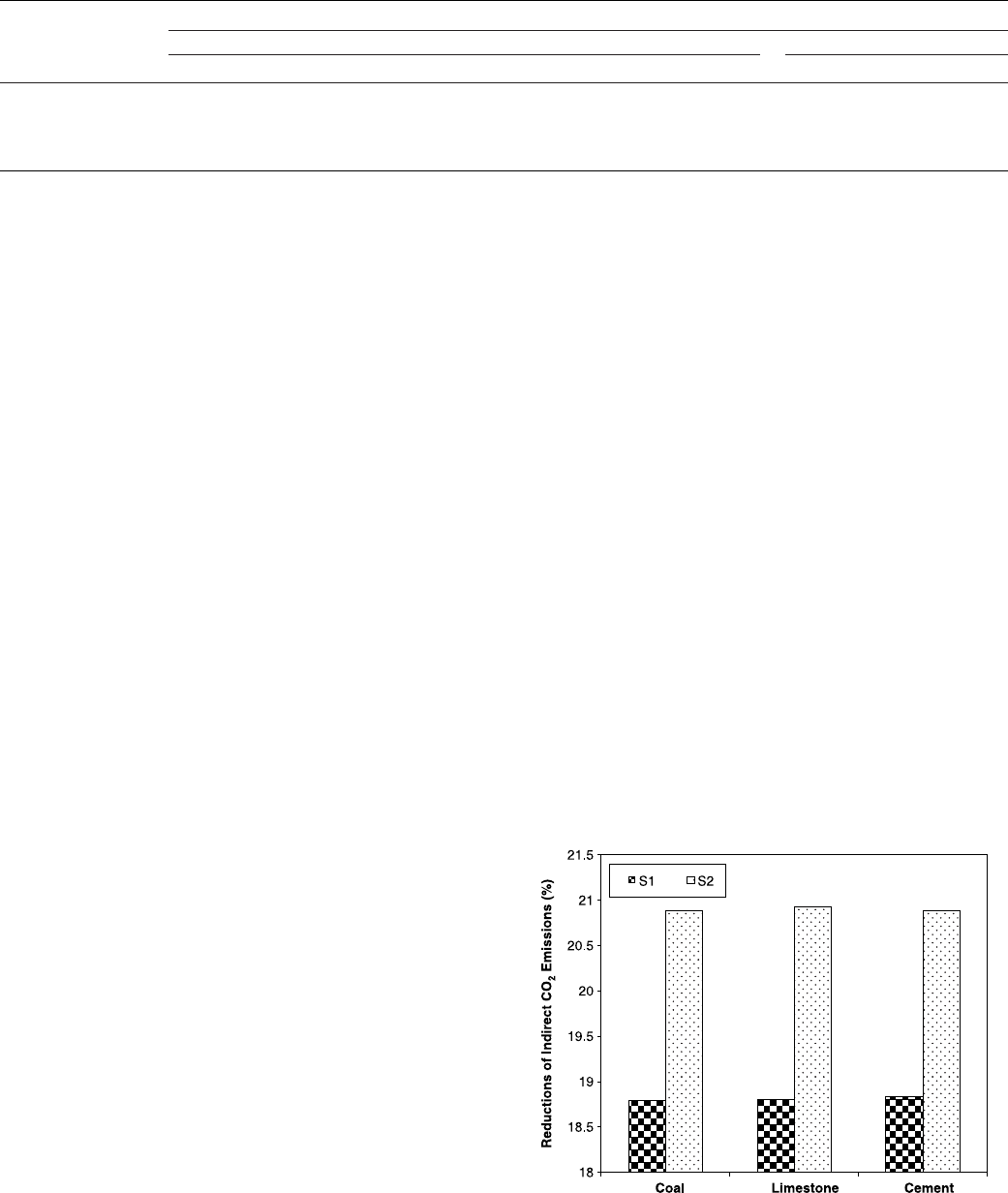
S1 and S2, respectively. There is a kink in Fig. 11
corresponding to the year 2006. This is due the incorporation
of policy options implemented from the year 2006 (except for
the 25% share from renewable energy). The renewable energy
is made effective from the year 2010, which is evident in the
form of another small kink.
Reductions in the CO
2
emissions are attributed to the
combined effect of all the mitigation options. The shares of
CO
2
emissions from the use of clinker, electric energy and
thermal energy for the BS and S2 scenarios are shown in Fig. 12.
In the case of BS, out of the total 396.88 million tonnes CO
2
emissions, 216.51 million tonnes comes from the clinker
consumption. This is 55% of the total share. In the case of
integrated scenario S2 the share of the CO
2
emissions (231.11
million tonnes) from clinker increases to 65%. However, the
percent share of CO
2
emissions from the thermal energy reduces
to 24% (55.46 million tonnes) for the integrated scenario S2.
6.2.4. Indirect CO
2
emissions
The indirect contribution to the CO
2
emissions from
cement industry related operations comes from the fossil-
fuel combustion in transporting the raw materials (coal and
limestone) to the industry and the finished product cement
to the market. For the year 2000, a total of 2.24 million
tonnes of CO
2
is estimated to have been released in
transporting coal to the cement industry. In this the share
from road transportation is 2.01, and 0.40 million tonnes are
from rail transport. This value is projected to reach 11.87,
9.64 and 9.39 million tonnes for the BS and S 1 and S2,
respectively, by the year 2020.
The impact of policy options on the percent reduction of
indirect CO
2
emissions from transport of the raw material
(limestone and coal) to the cement plants is shown in Table 2.
When the share of blended cement is increased, the coal
transport related CO
2
emissions come down. On increasing the
share of blended cement to 37% OPC, 45% PPC, 16% PSC and
2% zeolite Portland, emission reductions of 13.06, 29.46 and
31.26% for the BS, S1 and S2, respectively, are expected by the
year 2020. This is due to the reduced fuel requirement in the
case of blended cement. If the energy efficiency of the plants
could be improved to 2.9 Gj/tonne of clinker, a maximum
reduction of 32.35% in the CO
2
emissions for S2 is expected,
due to lowering of the coal consumption. In a combined
scenario of structural management and energy efficiency
improvement, the CO
2
emissions from the coal transport
come down by 58.80%. The CO
2
emissions from the transport
of limestone to the cement plants are projected to reach 12.66,
10.28 and 10.01 million tonnes by the year 2020 for the BS, S1
and S2, respectively.
In the baseline scenario transport of cement to the market
will contri bute 12.16 million tonnes of CO
2
emissions by the
year 2020. These emissions are estimated to go down to the
respective values of 9.87 and 9.62 million tonnes for
population growth stabalisation scenarios S1 and S2. Percent
reductions of indirect vehicular CO
2
emissions from the
transport of the raw materials (coal, limestone) to the cement
plants and cement to the market are shown in Fig. 13.
Emissions from the transportation of the materials by
road are obviously more than those by rail transport.
Railways consume the least direct fuel energy per tonne
kilometer and hence less CO
2
is emitted per tonne
kilometer. A reduction of approximately 85% in the CO
2
emissions is estimated if the freight transportation is shifted
from road to rail. Ramanathan and Parikh (1999) have
reported that the energy consumption and CO
2
emissions
per tonne kilometer by trucks are nearly five times the
corresponding values for rail transport.
Table 2
Impact of policy options on the reduction of indirect CO
2
emissions from raw material (limestone and coal) transport to the cement plants
Policy options Reduction of indirect (vehicular) CO
2
emissions from raw material transport (%)
Coal Limestone
BS S1 S2 BS S1 S2
TEEI 14.41 30.50 32.35 0.0 18.80 20.93
WHR 30.00 43.13 44.65 0.0 18.80 20.93
SM 13.06 29.40 31.26 13.11 29.46 31.28
TEEICWHRCSM 47.94 57.70 58.80 13.11 29.46 31.28
TEEI, Thermal energy efficiency improvement scenario where the specific energy consumption is decreased to 2.9 Gj/tonne cement production.
Fig. 13. Per cent reductions in indirect (vehicular) CO
2
emissions from transport
of the raw material (limestone and coal) to the cement plants and finished product
cement to market under the Scenario 1 (S1) and scenario 2 (S2).
S. Anand et al. / Journal of Environmental Management 79 (2006) 383–398396
7. Conclusi ons
A system dynamics model for the CO
2
emissions from the
cement sector was developed. The model was applied to make
projections of CO
2
emissions in India for a time span of 20
years. The cement production with the baseline scenario
(present rate of population growth) is projected to contribute
396.89 million tonnes of CO
2
to the greenhouse gas load by the
year 2020. Mitigation strategies for curtailing the CO
2
emissions from this sector are identified and analysed. The
CO
2
emissions from cement plants are dependent on many
interrelated variables, viz. population and GDP growth rate,
cement demand and production, clinker consumption and
energy utilized. Quantitative estimates of CO
2
emissions due to
stabilisation of the population growth, curtailment of excess
cement production, structural management, energy efficiency
management and a combination of all these measures have
been worked out. A combined scenario with population
stabilisation by the year 2010, structural shifting (2% zeolite
Portland, 4 5% PPC, 16% PSC and 37% OPC), 25%
contribution from renewable sources of energy for the cement
industry starting from the year 2010, and use of an energy
efficient process with 2.9 Gj/tonne specific energy consumption
and 30% thermal energy recovery from waste heat can reduc e
the CO
2
emissions from the Indian cement industry by
approximately 42% in the year 2020. This could be a
substantial lowering of the greenhouse gas load to the
environment.
Indirect CO
2
emissions coming from the transportation of
raw materials (coal and limestone) to the cement plants and
finished products (cement) to the market were also worked out.
The CO
2
emissions from road transport are more in comparison
to that from rail transport. Th us, a shift from the use of trucks to
the railways will also lead to a reduction in CO
2
emissions.
Acknowledgements
One of the authors (S.A.) thanks the Indian Institute of
Technology Delhi for the award of fellowship to carry out this
research work.
References
Anand, S., Dahiya, R.P. and Vrat, P. (2005) Investigations of methane
emissions from rice cultivation in Indian context. Environment Inter-
national 31, 469-482 (www.elsevier.com/locate/envint).
CEMBUREAU, 1996. Word Cement Directory, CEMBUREAU. The European
Cement Association, Brussels, Belgium.
CEMBUREAU, 1998. Cement Production, Trade, Consumption, Data: World
Cement Market in Figures 1913–1995, World Statistical Review 18.
CEMBUREAU—The European Cement Association, Brussels, Belgium.
CEMBUREAU, 1999. Cement Production, Trade, Consumption Data: World
Cement Market in Figures 1913–1995, World Statistical Reviews 19 and
20. CEMBUREAU—The European Cement Association, Brussels,
Belgium.
Choudhary, R., Bhakatvatsalam, A.K., 1997. Benefication of Indian coal by
chemical techniques. Energy Conversion and Management 38 (2), 173–
178.
CII, 1995. Specific energy consumption norms in India: Cement industry,
Chennai. Confederation of Indian industry.
Ford, A., 1996. Testing snake river explorer. System Dynamics Review 12,
305–329.
GHG Protocol-Mobile Guide, 2001. Calculating CO2 emissions from mobile
sources. Guidance to calculation worksheets (www.ghgprotocol.org/
standard/mobile.doc).
Government of India, 1997. Report to the Planning Commission. 9th Five
Year Plan, 1. (http://www.developmentfirst.org/India/planning-commis-
sion/9thfyp/FYPVol1.pdf).
Government of India, 2001–2002. Economic Survey. Ministry of Finance.
(http://indiabudget.nic.in/es2001-02/).
Guneralp, B., Barlas, Y., 2003. Dynamic modelling of a shallow fresh water
lake for ecological and economic sustainability. Ecological Modelling 167,
115–138.
Guo, H.C., Liu, L., Huang, G.H., Fuller, G.A., Zou, R., Yin, Y.Y., 2001. A
system dynamics approach for regional environmental planning and
management. A study for the lake Erhai Basin. Journal of Environmental
Management. 61, 93–111, www.idealibrary.com.
Hendriks, C.A., Worrell, E., Price, L., Martin, N., Ozawa Meida, L.,
1999. Greenhuse gases from cement production. IEA Greenhouse Gas
R & D Programme. Report # PH 3/7. Ecofys, Utrecht, The
Netherlands.
IIC, 2002. Industry, Finance and Business. International Investment Centre
Monthly Newsletter (July) (http://iic.nic.in/ifb0702.htm).
International Energy Agency, 1999. The reduction of greenhouse gas emissions
from the cement industry, Report PH 3/7, Paris, France.
Karavezysis, V., Timpe, K.P., Marzi, R., 2002. Application of system dynamics
and fuzzy logic to forcasting of municipal solid waste. Mathematics and
Computers in Simulation 2071, 1–10.
Karwa, D.V., Sathaye, J., Gadgil, A., Mukhopadhyay, M., 1998. Energy
efficiency and environmental management options in the cement Industry.
ADB Technical Assistance Project (TA:2403-IND). ERI, Forest Knolls,
Calif.
Khurana, S., Khurana, S., Banerjee, R., Gaitonede, U., 2002. Energy balance
and cogeneration for a cement plant. Applied Thermal Engineering 22,
485–494.
Marchal, G., 2001. Decreasing pollution. Cement and Building Materials
Review (3) (AUCBM).
Mashayekhi, A.N., 1993. Transition in New York state solid waste system: a
dynamic analysis. System Dynamics Review 9, 23–48.
McCaffrey, R., 2001. Climate change and the cement industry. GCL: Global
Cement and Lime Magazine (www.probubs.com/climate/climate.html.).
Mehra, M., Damodaran, M., 1993. Anthropogenic emissions of greenhouse
gases in India (1989–90), The Climate Change Agenda: An Indian
Perspective. Tata Energy Research Institute, New Delhi, India.
Mohapatra, P.K.J., Mandal, P., Bora, M.C., 1994. Introduction of System
Dynamics Modelling. Orient Longman Hyderabad, India.
Naill, R.F., Gelanger, S., Klinger, A., Petersen, E., 1992. An analysis of cost
effectiveness of US energy policies to mitigate global warming. System
Dynamics Review 8, 111–118.
Price, L., Worell, E., Martin, N., Lehman, B., Sinton, J., 2000. China’s
industrial Sector in an International Context. Proceedings of the Workshop
on ‘Learning from International Best Practice Energy Policies in the
Industrial Sector’, Bejing, China, 22–23. http://eetd.lbl.gov/ea/ies/suni6/
industry46273.pdf.
Ramanathan, R., Parikh, J.K., 1999. Transport sector in India: an analysis in the
context of sustainable development. Transport Policy 6, 35–45.
Saysel, A.K., Barlas, Y., Yenig, O., 2002. Environmental sustainability in an
agricultural development project: a system dynamics approach. Journal of
Environmental Management, 64, 247–260http://www.idealibrary.com.
Schumacher, K., Sathaye, J., 1999. India’s cement industry: Productivity,
energy efficiency and carbon emissions. LBNL-41842. Lawrence Berkley
National Laboratory, USA. http://eetd.lbl.gov/ea/ies/suni6/industry41842.
pdf.
Somani, R.A., Kothari, S.S., 1997. Die Neue Zementlinie bei Rajashree
Cement in Malkhed/Indien. ZKG International 8, 430–436.
S. Anand et al. / Journal of Environmental Management 79 (2006) 383–398 397
TEDDY 2000/2001. TERI Energy Data Directory & Yearbook, Pub: Tata
Energy Research Institute, New Delhi.
Vizayakumar, K., Mohapatra, P.K.J., 1991. Environmental impact analysis of a
coalfield. Journal of Environment Management 34, 73–93.
Vizayakumar, K., Mohapatra, P.K.J., 1993. Modelling and simulation of
environmental impacts of coalfield: system dynamics approach. Journal of
Environmental Systems 22, 59–73.
Vrat, P., Gupta Y.K., Gupta, A., 1993. A System dynamics study of
global warming. Proceedings of xviith National System Conference,
Kanpur.
World Energy Council, 1995. Energy efficiency improvement utilising high
technology: an assessment of energy use in industry and buildings. Prepared by
Marc D. Levine, Lynn Price, Nathan Martin and Ernst Worrell, WEC, London.
Worrell, E., Smit, R., Phylipsen, D., Blok, K., Vleuten, F., Jansen, J., 1995.
International comparison of energy efficiency improvement in the cement
industry. In: Summer Study on Energy Efficiency in Industry, ACEEE
proceedings, Washington, DC.
Wu, J., Barlas, Y., Wankat, J.L., 1993. Effect of patch connectivity and
arrangement on animal metapopulation dynamics: a simulation study.
Ecological Modeling 65, 221–254.
S. Anand et al. / Journal of Environmental Management 79 (2006) 383–398398
